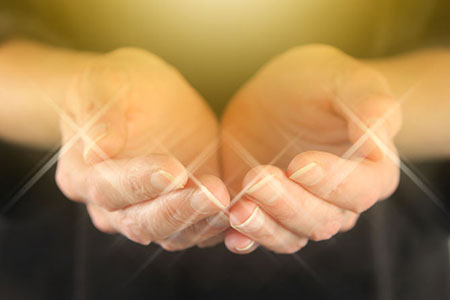spirituality
From Believing To Knowing
 “I wish I believed in the spirit world like you do,” my best friend commented many years ago. I then told her that it wasn’t so much a case of believing, but more of a matter of knowing.
“I wish I believed in the spirit world like you do,” my best friend commented many years ago. I then told her that it wasn’t so much a case of believing, but more of a matter of knowing.
Last week, a new friend asked me to teach him how to have this ‘knowing’ that I have. But I really have no idea how to do that? I never experienced a transition from believing to knowing. The ‘knowing’ has always just been there.
I have always felt that the spirit realm is our true connection to home. As the years passed, I began more and more to view planet Earth as our schoolroom. And boy can we get some lessons while we are here!
When I think back, I have recollections of spirit activity around me from when I was about five or six years old. My parents and I were living in Ottawa, Canada, at the time, where my dad had recently been employed. We were temporarily living in a creepy rental home, until my father found his feet and we would be able to move to a house with better vibes.
I recall seeing and hearing shadow beings in the hallway of that eerie house in Ottawa, and I remember telling my mother about the paranormal activity I sensed there. But she thought I was just imagining things, or seeking attention. I also recall lying in bed, scared, listening to what sounded like chattering voices. The energy in that old place wasn’t malevolent, but it didn’t feel benevolent either.
The most profound experience occurred when I was just nine years old. We had moved back to the United Kingdom and were visiting family friends. They were hosting a party, and the kids were sent off to bed, while the adults carried on with their social event below.
Your Soul Contract For Spiritual Evolution
 Your soul is quietly pushing you to experience and achieve certain things in this lifetime, because before we came here we designed a soul contract. There are certain challenges and traumas we put into this contract, to elevate our consciousness. Through our tears we conquer our fears.
Your soul is quietly pushing you to experience and achieve certain things in this lifetime, because before we came here we designed a soul contract. There are certain challenges and traumas we put into this contract, to elevate our consciousness. Through our tears we conquer our fears.
We don’t elevate all at the same rate. Our purpose here is to elevate spiritually as speedily as we can, without harming or hurting others. The purpose of our evolution process is to complete the contract, or fulfill the mission.
Each person’s journey is unique and very personal. Sometimes our families do not support us in our soul evolution, and friends may not understand what is going on in your life, but this is not about anyone else except you!
When we evolve spiritually, we develop a higher consciousness and become a better version of ourselves. But in order to elevate, we have to want to learn, grow and expand. In order to evolve, you have to let go of anything that is holding you back. People often struggle with this, but no matter what, we have to be willing to change and grow. To become our better self, we have to learn our lessons in this lifetime.
We all have our own path and our spiritual journey, because we have our own specific blueprint when we arrive on the planet. It pretty much outlines what we are intending to accomplish in this lifetime, and why we chose to come here at this time.
Spiritual Awareness In A Time Of Isolation
 Many of us are currently experiencing varying levels of real isolation and solitude – some for the first time ever. This can be a blessing in disguise, as it affords us the opportunity to ‘clean house’ physically, mentally, emotionally, and also spiritually. So, if you’re by yourself right now, there are some easy, productive ways to raise your levels of spiritual awareness.
Many of us are currently experiencing varying levels of real isolation and solitude – some for the first time ever. This can be a blessing in disguise, as it affords us the opportunity to ‘clean house’ physically, mentally, emotionally, and also spiritually. So, if you’re by yourself right now, there are some easy, productive ways to raise your levels of spiritual awareness.
Meditation is one of the oldest and most universal methods to connect to the spirit realms and become more aware of oneself. When we meditate, our vibrations and levels of energy will increase, and our consciousness is raised. You may also want to try creative visualization, affirmations, mantras, or physical activities, such as Yoga or Tai Chi.
Getting to know your spirit guides is something you may have never done before, and now is the ideal time to do so. These spiritual beings are always by our side, willing to hel and be of service. Ask them who they are and what they can do for you. Trust in their presence and their intentions.
You can also work on opening the third eye and developing your psychic attunement. During your meditations, imagine the spot between your eyebrows opening wide and increasing your levels of sight and clairvoyance.
And how about experimenting with psychometry, the art of reading an object’s energy? It’s especially helpful if you want to communicate with someone who has passed away. If you have something belonging to a late grandparent or another loved one, such as a piece of jewelry or item of clothing, hold the item and focus on what it tells you.
Transcending Turbulence And Restoring Peace Within
 One of the most moving metaphors I have ever heard, describes the calm that rests beneath the surface of the ocean. While there may be waves and turbulence on the top, if you dive down deeper, you will come to waters that are more still.
One of the most moving metaphors I have ever heard, describes the calm that rests beneath the surface of the ocean. While there may be waves and turbulence on the top, if you dive down deeper, you will come to waters that are more still.
Similarly, the troubles of life that bring disturbance to the body, mind, and relationship dynamics of the world, occur at levels which are external to the eternal self. By going deeper, peace within can be found.
Spiritual traditions of the world define the self and the soul in varying ways. The ancient Vedic texts, for example, identifies the individual soul as measuring one ten-thousandth the size of the tip of a hair, and states that it is located in the region of the heart, seated beside the Paramatma, or Supreme Soul (God).
In the Vedic tradition, consciousness is recognized as the symptom of the soul, which is carried throughout the body by the blood, as it is circulated by the beating heart. When the heart stops and consciousness leaves the body, it is because the soul has departed.
Lord Krishna further describes in Bhagavad-gita that this atomic soul is never born, and never dies. It is immutable, unchangeable, indestructible, and always aloof from matter and its influences.
These spiritual teachings go on to highlight that the pure eternal soul is one’s real identity – the ‘I’ or ‘me’ felt by each and every living being. In this world, it has become temporarily covered by a subtle body made up of mind, intelligence, and false ego, as well as by the physical body comprised of earth, water, fire, air, and ether. In this state, the modes of material nature act upon it, and one acts out various behaviors compelled by the energies of those coverings. But the soul itself remains untouched and unaffected.
Transmuting The Negative Energy Of Self-Sabotage
 In many religions and spiritual wisdom traditions we find guidelines on healing and mind-body wellness. Many of these philosophies, in conjunction with modern medicine, can be a great aid for mind, body and soul. In all spiritual traditions there are usually rules or recommendations aimed at the well-being of society as a whole, as well as each individual soul. Many of these teachings warn us of dangers we might find in our own thought, choices and actions. And if we are unaware or careless, a damaging thought or action can turn into a harmful pattern.
In many religions and spiritual wisdom traditions we find guidelines on healing and mind-body wellness. Many of these philosophies, in conjunction with modern medicine, can be a great aid for mind, body and soul. In all spiritual traditions there are usually rules or recommendations aimed at the well-being of society as a whole, as well as each individual soul. Many of these teachings warn us of dangers we might find in our own thought, choices and actions. And if we are unaware or careless, a damaging thought or action can turn into a harmful pattern.
Recognizing a damaging thought or behavior pattern in our lives is not easy. We might realize that someone else makes the same mistakes over and over, but it may be difficult to have the same insight about ourselves. We create the imagined walls of our own limitations, and abide by them, without being aware of making this decision. These limiting, destructive thoughts and actions that appear repeatedly in our lives – especially those demeaning, self-sabotaging, angry thoughts – are in essence negative energy vibrations. A few example of such thoughts can be:
I am useless and incompetent.
I am not strong enough.
Nobody cares about me.
I do not deserve better.
I hate myself.

